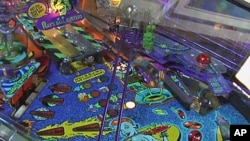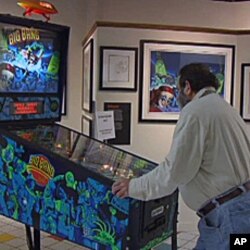Washington D.C. is filled with some of America's best known museums and many more less famous ones. Take a look inside one of those lesser-known establishments, and you'll find a place filled with passion, noise, and a speeding silver ball.
"Most of my life I've been involved somehow in pinball, whether its thinking about buying a game or playing games in different places when I saw them, David Silverman said. "I've been collecting pinball machines about 30 years."
Pinball is a game in which players launch a metal ball into a glass-enclosed area. The game awards points the longer the ball stays in play. But look out! One false move… the ball sinks… and the round is over.
Today Silverman is the proud owner and curator of the National Pinball Museum in Washington D.C., and it all started with a game he played in Spain 30 years ago called Fireball.
"It was so fascinating to me and I had never seen it before. And that game fortunately or unfortunately started me on this collection phase which was not with the intention of doing anything but playing the game, he said. "I don't know what happened, I just kept buying games and buying games, it really is a blur, it like almost 30 years of a blur, but today the blur has ended at about 900 games."
Then, 15 years ago Silverman got serious he explains. ""I started seriously collecting for the purpose of building a museum. What pinball shows in the almost hundred years of its existence is the development of the United States. If you take any period of American history and say okay the [19]60s, and you follow the pinball games that were made in the 60s, you would see exactly what took place in the 60s. So besides it being a historic timeline of events, it's an artistic timeline, it's a cultural timeline, and of course its still a game, so the game improved."
But pinball is more than just a "flip" through history. "I play pinball as an enjoyment, and I play it as a game to get better at. So I play it with seriousness and I play it for fun," he said. "To me a good portion of the excitement of a pinball machine is what the sound is, the sound tells you what's going on with the story. If it's just a huge jumble of noise, you have to be a helluva lot better pinball player then I am because I really want to hear what's going on, it tells me you have done something, it tells me you missed it".
But can pinball survive the world of electronic gaming?
"The three-dimensionality of pinball, I'm not talking pinball on the computer, I'm talking about the real pinball machine -- to me that's the hope of pinball, to get these kids seeing what pinball is or was before, so they can be interested in continuing playing it.
The whole point or one of the many points of this museum, was to start a little fire under people in terms of, not just seeing pinball as a game to play but as pinball a piece of historic art," Silverman states.
Despite spending almost $2 million over the past 30 years, Silverman says his investment is in history and the love of the game. "It's obviously a passion, I'm hoping to make it a passion of a lot other people," he said.
If Silverman can make others feel as passionately as he does then he might earn the game's highest accolade - being called a "Pinball Wizard."







